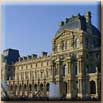

 History of Museums
History of Museums
Not until the Renaissance (14th century to 17th century) was the term
museum applied to a collection of objects of beauty and worth. The first museum,
founded about 290 BC in Alexandria, Egypt, by Ptolemy I, was a community of
scholars; objects also were housed in the community and used for teaching. Ancient
Greek and Roman temples and other public spaces contained art objects dedicated
to the gods. Before the year AD 1000 royal collections of art objects were preserved
in palaces and temples in China and Japan.
During the Middle Ages (5th century to 15th century) European churches and monasteries
became repositories for art and other valuable objects.
In the 16th century it became customary to display sculpture and paintings in
the long halls, or galleries, of palaces and the residences of the wealthy.
Thus originated the use of the term gallery for a place where works of art are
hung or arranged for viewing.
Museums as they are known today were first established in Europe in the 18th
century. During the French Revolution (1789-1799), the Louvre
became the first great public art museum. Relatively early in the history
of modern museums, special types began to be organized, including university
museums; art museums; museums devoted to national, regional, or local history;
and science museums.
The physical condition of museum objects is the responsibility of specially
trained conservators and restorers. Educational activities at museums include
the interpretation of collections through permanent displays and special exhibitions,
programs for school children, guided tours of the museum, lectures and trips
for adults, television and radio programs, film series, and performing arts
programs. Many museums lend objects to other institutions for exhibition purposes;
many also organize exhibitions that travel to different locations. Art
| |
||
| "The Louvre is a morgue;you go there to identify your friends". Jean Cocteau (1889-1963), French author, filmmaker. Quoted in: Roger Shattuck,"A Native Son of Paris" (1984). |
museums customarily publish catalogs of their collections and exhibitions. Most major museums also establish and maintain libraries for research and the documentation of their collections. Museum Organization as nonprofit institutions, museums are customarily governed by a board of trustees. The board of trustees usually hires the museum's director, who is the chief executive officer and fund-raiser of the institution. Directors, working closely with the curators and heads of various departments, act as liaisons between the staff and the board. Funding for many exhibitions traditionally has been obtained from municipal, regional, state, and federal sources, as well as from the private sector, including foundations. Recent cuts in public funding and increased competition for money from private sources, coupled with inflation and increases in taxes, have led museums to seek new sources of revenue. Museum memberships, sales of publications, and reproductions in gift shops and by mail order are among the means of raising funds. Admission fees have been adopted by some museums but are opposed by others. |
 |
Pablo Picasso (1881-1973), Spanish artist. "Conversation avec Picasso," in Cahiers d'Art, vol. 10, no. 10 (Paris, 1935; tr. in Alfred H. Barr, Jr., Picasso: Fifty Years of His Art, 1946). |
|
||||||
|
||||||
| Louvre | Russian State Museum | d'Orsay | ||||
| Metropolitan Museum | ||||||